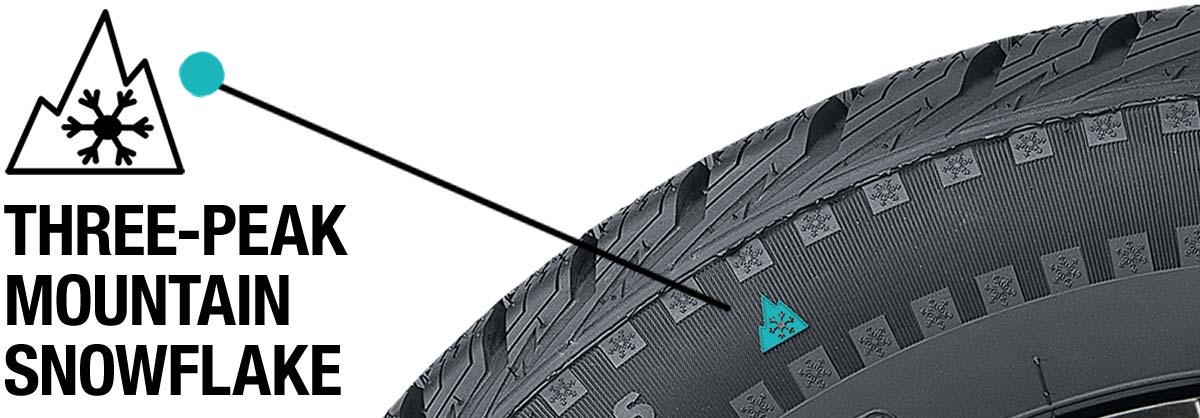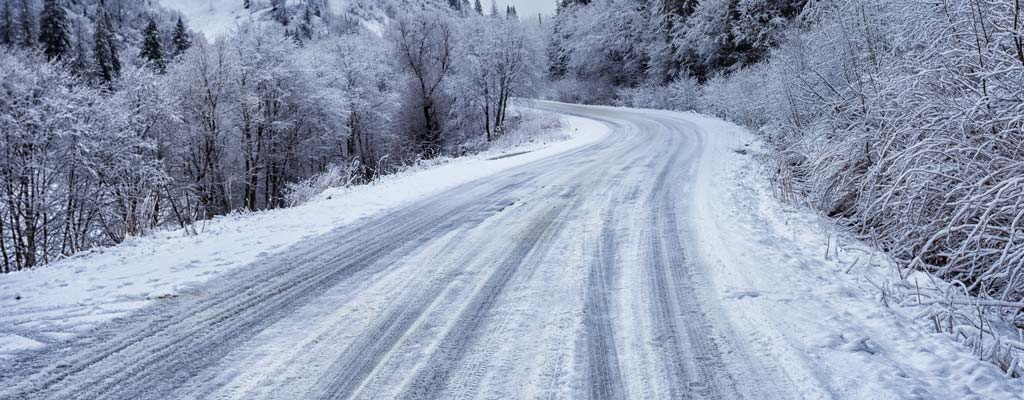Are All-Terrain (A/T) and Mud Tires (M/T) Good in the Snow?
The answer to that question is, it depends. All-terrain (A/T) tires offer decent performance in light snow thanks to an aggressive tread pattern, while mud-terrain (M/T) tires give you added grip in some winter conditions due to large tread blocks designed for added traction in the mud. Here’s why A/T and M/T tires might not perform as well as a dedicated set of snow tires.
Can I Use All-Terrain Tires in the Snow?
Yes, A/T tires offer year-round usability and some traction in light snow. When choosing a set of A/T tires that will face snow-covered roads, be sure they feature the three-peak mountain snowflake (3PMSF) symbol on the sidewall. This indicates the tire has met specific criteria for winter performance and safety. However, while the 3PMSF designation does qualify as a winter traction device on mountain passes, a dedicated set of winter tires can offer the best traction and control on the worst winter roads.
Can I Use Mud Terrain Tires in the Snow?
Yes, M/T tires can be used in light snow. However, the rugged tread on mud-terrain tires are primarily designed for off-road use on rocks, dirt, and mud. Their usefulness in the snow and ice is limited. While the tread design may work well in unpacked snow, the lack of siping, larger surface area, and biting edges can limit traction in packed snow, ice, and slippery conditions. Yet another reason to get a set of snow tires for severe winter driving conditions.
What Are All-Terrain (A/T) Tires?
All-terrain tires are a nice mix of highway tires (H/T) and mud-terrain (M/T) tires. They’re great for daily driving to work, camping on the weekend, and occasional trips over the mountains thanks to more space between tread lugs and an open shoulder tread design. Some A/T tires are severe snow-rated, qualifying as traction tires or devices. This means they can be used over mountain passes and/or anywhere these devices are required. To qualify as a traction tire or device, these tires must have a three-peak mountain snowflake (3PMSF) symbol on the sidewall.
You can find the best all-terrain tires for your vehicle at Les Schwab.
What Are Mud-Terrain (M/T) Tires?
Mud-terrain tires are designed for off-road conditions. The tread pattern on M/T tires has huge spaces between the lugs and a very large open-shoulder design. They look rugged because they are. They can perform in light snow and rain, but are purpose built for mud, dirt, gravel, rock, and other extreme conditions. However, they are not ideal in packed snow and ice. That's because the aggressive tread on M/T tires generally lacks siping (the small slits in the tread that provide gripping edges). This, combined with the larger lug shape and wider voids between lugs as well as less flexibility in colder temperatures, reduces traction on adverse road surfaces.
Choose the right off-road M/T tires at Les Schwab.
Mud Terrain vs All Terrain Tires
| M/T Tires | A/T Tires | |
|---|---|---|
| Primary Design | Designed primarily for off-road conditions like mud, rocks, and rough trails. | Designed for both off-road and on-road use. Versatile for a range of conditions. |
| Tread Blocks | Large, chunky with wide voids | Balanced tread pattern with a mix of larger and smaller tread blocks. |
| Voids Between Treads | Wide | Moderate |
| Siping (small slits in tread blocks) | Often lack siping (which can help grip on wet roads and snow). | Often include siping (enhancing grip on wet and snowy surfaces). |
| Appearance | More aggresive | Less aggressive |
| Road Noise | Potentially louder road noise when driving on highways. | Typically quieter |
| Rubber Compound Flex | May have a harder rubber compound, making them less flexible in cold conditions. | Rubber compound is usually formulated to remain flexible over a broader range of temperatures. |
| Weather/Road Conditions | Mud, rocks, rough trails | Wet roads, light snow, dirt, gravel |
How Do I Tell What Tires Are Fit For Snow
Dedicated winter or snow tires are specifically designed to remain pliable at or below 40º F. This flexibility, along with specialized sipes to move away slush at higher speeds, helps you stay in control in colder temperatures and offers better braking, cornering, and control on snow and ice.
These tires, along with some A/T and all-weather options, feature the 3PMSF (three-peak mountain snowflake) symbol or icon. You’ll find this symbol on the tire’s sidewall. If you find the 3PMSF icon, you can be sure those tires have met strict U.S. safety tests, allowing them to be classified as traction tires or devices.

Consider Buying Dedicated Snow Tires
When you put a set of snow tires on your car or truck, you’re adding safety to every commute and winter adventure. That’s because winter or snow tires are crafted with specialized rubber that allows them to remain softer in cold temperatures, providing enhanced traction in harsh winter conditions. Larger grooves, specialized sipes, biting edges, studs, and varied tread block shapes help improve grip on snow and ice.
A/T, M/T, as well as all-season tires are designed for other types of conditions. That includes a different rubber compound that helps grip the road in warmer temperatures. If you live in a region that faces frequent snowfall, icy roads, or if you travel nearby mountain passes often, buying a set of snow tires can be a smart, safer choice for you and your family.
Let Les Schwab Handle Your Snow Tire Needs
Rain, snow, and ice don’t stand a chance when you have the right tires. Les Schwab can show you all of your options and add confidence to every outing. Schedule your free pre-trip safety check. Be sure to ask about winter chains and how to install them while you’re there.
What you need to know

How to Choose Winter Tires: Complete Buying Guide & FAQs
Learn how to choose the best winter tires for your vehicle with our guide. Get expert tips, understand tire differences, and explore top FAQs from Les Schwab.

What Are All-Terrain (A/T) Tires & What Are They Used For?
All-terrain (A/T) tires are designed to provide traction on and off road in wet, dry, and lightly snowy conditions. Learn if they are the right fit for you.

When to Choose All-Terrain Tires or All-Weather Tires
Wondering what the difference between all-terrain and all-weather tires is? Read this article to find out the key differences, and which tire suits you best.

